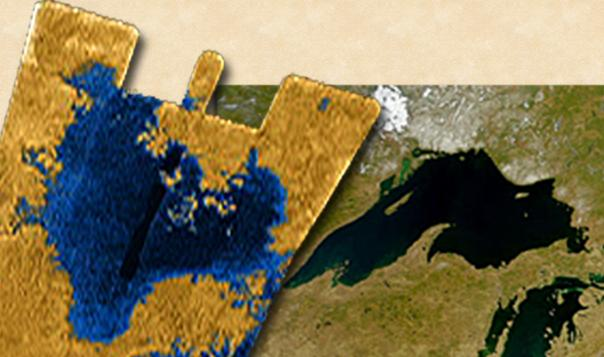The lakes of liquid methane and ethane on Titan have shorelines that appear to have been shaped by waves on those hydrocarbon lakes, new evidence suggests, potentially settling an old argument. It could also shape the forthcoming mission to Saturn’s giant moon.
When it comes to finding a world we can study for its resemblance to the early Earth, the best the Solar System has to offer is not another planet, but a moon. Titan is the only moon we know of with a substantial atmosphere, and one that is more similar to Earth’s than the wispy near-nothings of Mars or the boiling acidic hell of Venus. That atmospheric pressure allows lakes and seas of molecules that are liquid far below the freezing point of water, fed by rivers from hydrocarbon rains on higher ground.
All these features created great excitement around the time the Voyager missions went past, but interest faded, other than around the time the Huygens probe touched down, as smaller moons took the spotlight. Now, as NASA prepares for the Dragonfly mission to explore Titan, the focus is swinging back, and planetary scientists want to know what to expect in order to tweak Dragonfly’s plans.
As part of that process, MIT’s Professor Taylor Perron has sought to answer the question of whether large waves develop on Titan’s lakes, something that would have many important implications. Past investigations have produced conflicting answers.
Perron and colleagues looked at the way waves erode the boundaries of large lakes on Earth, and compared this to images sent by Cassini of the outlines of Titan’s largest lakes. They acknowledge their results are not definitive – after all, Cassini only made flybys of Titan while orbiting Saturn, so the resolution of its images was not as good as we would like.
“We can say, based on our results, that if the coastlines of Titan’s seas have eroded, waves are the most likely culprit,” Perron said in a statement. “If we could stand at the edge of one of Titan’s seas, we might see waves of liquid methane and ethane lapping on the shore and crashing on the coasts during storms. And they would be capable of eroding the material that the coast is made of.”
Establishing the existence of waves has implications far beyond the shorelines. The occasional meteorite may trigger waves when landing in a lake, but such events would be even rarer on Titan than on Earth. Waves frequent enough to erode shorelines would be a sign of strong winds.
First author of the paper reporting the findings, Rose Palermo, noted that efforts to see if waves occur had looked at Cassini’s images of the lakes themselves, trying to assess if they were still or choppy.
“Some people who tried to see evidence for waves didn’t see any, and said, ‘These seas are mirror-smooth,’” Palermo said. “Others said they did see some roughness on the liquid surface but weren’t sure if waves caused it.”
Besides the challenge of making these images out, we know Earth’s largest lakes can go from calm to storm so fast they seem enchanted. An absence of waves at any one time is hardly conclusive.
If the work of Palermo, Perron, and co-authors is confirmed, it would allow us to improve models both of Titan’s atmosphere and how the lakes and seas move. Ideally, we might be able to determine how large a lake on Titan needs to be to develop shore-eroding waves, and whether winds and waves are stronger at certain latitudes, as they are on Earth.
The team first sought to determine whether the shores were eroded at all, modeling their evolution from flooded river valleys. The next question was whether the erosion looked more like what would be created by waves or other processes, using what we know about Earth’s lakes as a comparison point.

A comparison of Titan’s largest “sea” as viewed by Cassini with Lake Superior at the same scale.
Image credit: NASA/JPL-Caltech/GSFC
To simulate wave-driven erosion, the authors needed to know wave height, which they modeled using what is known as “fetch”, which truly does happen, being the distance wind can blow unobstructed over water or another liquid.
“Wave erosion is driven by the height and angle of the wave,” Palermo explains. “We used fetch to approximate wave height because the bigger the fetch, the longer the distance over which wind can blow and waves can grow.”
The areas around four of Titan’s largest liquid bodies, comparable in size to North America’s Great Lakes, were then compared with these models.
“We found that if the coastlines have eroded, their shapes are more consistent with erosion by waves than by uniform erosion or no erosion at all,” said Perron.
“We had the same starting shorelines, and we saw that you get a really different final shape under uniform erosion versus wave erosion,” Perron added. “They all kind of look like the flying spaghetti monster because of the flooded river valleys, but the two types of erosion produce very different endpoints.”
Now the quest is on to calculate the strength and direction of the winds required to create such erosion.
We do space research because curiosity is natural to humans, but it can sometimes reveal unexpected benefits at home. By exploring how erosion occurs in the absence of humans, Palermo thinks we may learn how to better protect Earthly coastlines from damage.
The study is published in Science Advances.
Source Link: The Shores Of Titan’s Lakes Appear To Be Shaped By Waves